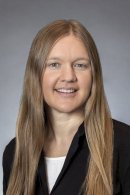Andrea Kunder, Ph.D.

Associate Professor, Physics
- akunder@stmartin.edu
- 360-688-2678
Ernsdorff Center 130
Area of Expertise
- Physics
Education
Ph.D., Dartmouth College
B.A., Willamette University
Background
Professor Kunder received her bachelor’s degree from Willamette University and her Ph.D. from Dartmouth College. Her area of expertise is astrophysics, with more than 80 refereed scientific publications, including being an editor of an Astronomy Society of the Pacific Conference Series. Professor Kunder came to Saint Martin’s University after a postdoctoral fellowship at the Leibniz Institute of Astrophysics (AIP) in Germany, and the Cerro Tololo Inter-American Observatory in Chile. She has been teaching at Saint Martin's University since 2017.
Publications with Saint Martin's undergraduates:
Bold names indicate undergraduates working with Dr. Kunder.
- Andrea Kunder, Prudil, Z., Skaggs, C., Reggiani, H., Nataf, D.M., Hughes, J., Covey, K., Devine, K. (2024) "The Galactic Bulge exploration III.: Calcium Triplet Metallicities for RR Lyrae Stars”, The Astronomical Journal, 168, 139
- Andrea Kunder, Prudil, Z., Covey, K.R., Hughes, J., Joyce, M., Simion, I.T., Kuss, R., Campos, C., Johnson ,C.I., Pilachowski, C.A., Larson, K.A., Koch-Hansen, A.J., Marchetti, T., Rich, M.R., Butler, E., Clarkson, W.I., Rivet, M., Devine, K., Vivas, A.K., Perren, G.I., Soto, M., Silva, E. (2024), “The Milky Way Bulge Extra-tidal Star Survey: BH 261 (AL 3)” The Astronomical Journal, 167, 21
- Evan Butler, Andrea Kunder, Prudil, Z., Covey, K.R., Ball, M., Campos, C.,Gollnick, K., Olivares Carvajal, J., Hughes, J., Devine, K., Johnson, C.I., Vivas, K.A., Rich, R.M., Joyce, M., Simion, I.T., Marchetti, T., Koch-Hansen, A., Clarkson, W.I., Kuss, R. (2024), “RR Lyrae Stars Belonging to the Candidate Globular Cluster Patchick 99” The Astronomical Journal Letters, 963, 33
- Andrea Kunder, Crabb, R.E., Debattista, V.P., Koch-Hansen, A.J., Huhmann, B.M. (2021) "Spectroscopic Observations of Obscured Populations in the Inner Galaxy: 2MASS-GC02, Terzan 4, and the 200 km/s stellar peak” The Astronomical Journal, 162, 86
- Andrea Kunder & Butler, E. (2020), "Spectroscopic Analysis of the Bulge Globular Cluster ESO 456-SC38" The Astronomical Journal, 160, 241
- Andrea Kunder, Pérez-Villegas, A., Rich, R. M., Ogata, J., Murari, E., Boren, E., Johnson, C. I., Nataf, D., and 6 coauthors (2020) "The Bulge Radial Velocity Assay for RR Lyrae Stars (BRAVARR) DR2: A Bimodal Bulge?" The Astronomical Journal, 159, 270
- Andrea Kunder, Tilton, A., Maertens, D., Ogata, J., Nataf, D., Rich, R. M., Johnson, C.I., Gilligan, C., Chaboyer, B. (2019) "Are the double-mode bulge RR Lyrae stars with identical period-ratios the relic of a disrupted stellar system?" The Astrophysical Journal Letters, 877, 17
- Andrea Kunder, Mills, A., Edgecomb, J., Thomas, M., Schilter, L., Boyle, C., Parker, S., Bellevue, G., Rich, R. M., Koch, A., Johnson, C. I., Nataf, D. M. (2018) "Radial Velocities of RR Lyrae Stars in and around NGC 6441" The Astronomical Journal, 155, 171
Recent accomplishments:
- 2024 NSF Astronomy and Astrophysics Research Grant (153,169)
- 2023 best physics and engineering poster at the Murdock College Science Research Conference awarded to Kunder's student, Claire Skaggs
- 2021 Lynwood W. Swanson Promise for Scientific Research Award (10,000 USD)
- LSST “Kickstarter Grant Partnership Proposal" (30,000 USD)
- NSF Astronomy and Astrophysics Research Grant (187,394 USD)
- RAISE: Research Across Institutions for Scientific Empowerment Grant (Collaboration with Seattle University, Western Washington University, College of Idaho ($370,066 USD)
- Murdock College Research Program for Natural Sciences - Physical Sciences grant (63,000 USD)
- 2020 best physics and engineering poster at the Murdock College Science Research Conference awarded to Kunder's student, Riley Crabb
Research interests:
Many of Dr. Kunder's scientific projects to date have involved observations of stars over large areas of the sky, acquiring both spectra and images of celestial objects to determine their properties. She is an expert in using old stars to study the Galactic bulge, and is the principal investigator of the Bulge Radial Velocity Assay for RR Lyrae stars (BRAVA-RR), a survey funded by the National Science Foundation. Kunder has also had a hand in characterizing several astronomical instruments used by the US National Observatory in Chile.
